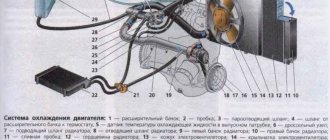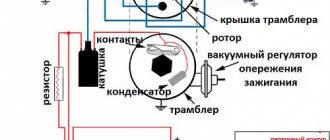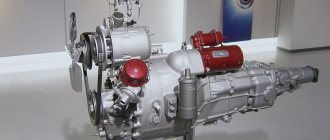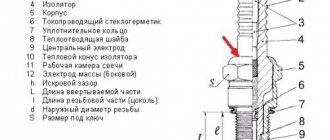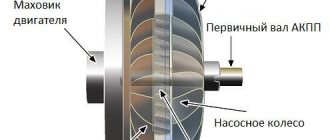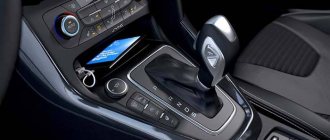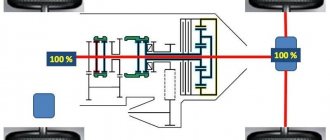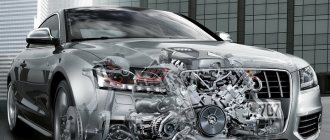Parking is not the easiest maneuver a driver has to perform, but it is an integral part of the entire process of driving a vehicle. Cars are not parked anywhere and anytime, taking up sidewalks, playgrounds and roadways. And sometimes you have to park a car in such difficult conditions, in which lack of space is not the most important obstacle. An automatic parking system can provide significant assistance in this process.
What is an intelligent automatic parking system
The automatic parking system is a complex of sensors and receivers. They scan the space and provide safe parking with or without driver assistance. Automatic parking can be performed either perpendicular or parallel.
Automatic car parking system
Volkswagen was the first to develop such a system. In 2006, the innovative Park Assist technology was introduced on the Volkswagen Touran. The system became a real breakthrough in the automotive industry. The autopilot performed parking maneuvers on its own, but its capabilities were limited. After 4 years, engineers were able to improve the system. Currently, it is found in many brands of modern cars.
The main goal of automatic parking is to reduce the number of minor accidents in the city, as well as to help drivers park their cars in limited spaces. Auto parking is turned on and off by the driver independently, as needed.
Warranty
Typical Warranty period is 1 year from the date of commissioning of automatic parking, subject to the conclusion of a maintenance agreement. There is a flexible system for extending or increasing the warranty period, as well as post-warranty service and equipment modernization.
We don't just sell equipment, we offer a solution for your parking, which we will service and support throughout the life cycle of the parking system.
Additional information on automatic parking can be obtained by phone or email. email [email protected]
Main components
An intelligent automatic parking system works in conjunction with various devices and components of the car. Most automakers develop their own systems, but they all incorporate certain elements, including:
- Control block;
- ultrasonic sensors;
- on-board computer;
- actuators.
Not every car can be equipped with a self-parking function. For optimal performance, the package must include electric power steering and an automatic transmission. The sensors are similar to parking sensors, but have an increased range. Different systems differ in the number of sensors. For example, the well-known Park Assist system has 12 sensors (four each in front and rear, the rest on the sides of the car).
Operating principle of intelligent parking systems
After pressing the system activation key, the control unit begins to work, receiving data from sensors and calculating the optimal trajectory of movement, taking into account its current spatial position. After this, the corresponding commands are transmitted to the actuators that are part of the complex called the autopilot.
The operation of the car parking system is impossible without coordination with many other electronic systems (vehicle directional stability, control of the operation of the power unit, automatic transmission, electric power steering, etc.). The main control unit has assistants who are responsible for interacting with other electronic systems.
Schematically, the operation of an automated parking system can be divided into two stages: searching for a free parking space and actually performing the maneuver.
How the system works
When the system is activated, the search for a suitable location begins. Sensors scan the space at a distance of 4.5-5 meters. The car moves parallel to a number of other cars and as soon as a place is detected, the system will notify the driver about it. The quality of space scanning depends on the speed of movement.
When parallel parking, the driver must choose the side on which to look for a suitable space. Also, the parking mode must be turned on 3-4 meters before the desired location and drive this distance for scanning. If the driver misses the suggested location, the search begins again.
Parallel parking
Next, the parking process itself begins. Depending on the design, there may be two parking modes:
- auto;
- semi-automatic.
In semi-automatic mode, the driver controls the speed of the car using the brake pedal. Idle speed is enough for parking. During parking, the steering and stability control systems are controlled by the control unit. The information display screen prompts the driver to stop or change gear to move forward or reverse. By maneuvering using power steering, the system can easily and safely park the car. At the end of the maneuver, a special signal will notify you of a successful operation.
Automatic mode eliminates driver involvement completely. All you need to do is press a button. The system itself will find a place and perform all maneuvers. The control unit will control the power steering and automatic transmission. The driver can even get out of the car and watch the process from the side, starting and turning off the system from the control panel. You can also switch to semi-automatic mode at any time.
What is an intelligent car parking system?
For a long time, only premium-segment cars were equipped with parking sensors, but in the 2000s, the function became available to “mere mortals.” However, as soon as parking sensors ceased to be a privilege of the luxury segment, engineers came up with a new assistant for the rich: a rear view camera that transmitted a picture of what was happening behind the rear bumper of the car directly to the monitor in front of the driver.
This option also had an ancestor: in 1956, the Buick Centurion concept appeared, equipped with a unique panoramic windshield. The concept car did not have rear-view mirrors - they were compensated by a rear-view system, which consisted of a movie camera located behind the car and a monitor on the instrument panel. And in 1972, the Swedish Volvo presented its famous Experimental Safety Car concept: one of the technologies used in the car was also a rear view camera, which externally corresponded to the level of technology of that time. Directly above the rear bumper, in the place where the license plate was attached, there was a lens, gigantic by today’s standards, which transmitted the image to a kinescope inside the cabin. This car can be seen alive today in the Volvo Museum on the island of Hisingen.
The solution with a camera turned out to be in demand much later and, first of all, on large vehicles - buses and trucks. And only then the cameras reached ordinary civilian cars. Another indisputable advantage of this device is its decent light sensitivity, which made it possible to clearly see obstacles not only in the daytime, but also in the dark. Alas, it is difficult to say exactly who was the first to install a rear view camera on a production car. One can only assume that one of the first production cars with smart technology was the Toyota Soarer Z3, released in 1991 for the domestic Japanese market (this car turned out to be very technologically advanced for its age: it even featured a touchscreen monitor that allowed climate control).
Here's how it works: in the rear of the car there is a wide-angle camera that transmits a horizontally inverted (mirror) image to a monitor in the cabin. The picture is flipped to match the view in the side mirrors. By the way, the camera in no way replaces the mirrors - it only complements the objective picture of what is happening around the car. As a rule, the camera and monitor begin to work simultaneously when reverse gear is engaged. Over time, the device was even taught to independently draw the best parking trajectory. The main disadvantage of the camera was initially its vulnerability: snow or dirt that got on the lens reduced all its advantages to nothing. Today, many brands have solved this problem by teaching the camera to be located outside the car only when driving in reverse: the rest of the time the lens remains securely hidden, for example, inside the emblem at the back of the car.
When it became clear that one camera could not give a complete picture of what was happening around the car, experts decided to create a all-round viewing system. The first experience of such a system can be considered an experiment with a mobile camera for Range Rover, which appeared in the early 2000s. The camera could be freely moved up to 5 meters from the car and the world around us could be viewed in detail. The invention turned out to be convenient for off-road use.
The Japanese installed the familiar full-fledged all-round visibility system on the production car. The updated Nissan Elgrand, introduced in 2007, received four cameras with a viewing angle of 180 degrees. The entire system, called Around View Monitor, consisted of four cameras, four parking sensors, a control unit and a monitor.
The cameras were located around the perimeter of the van (in the front and rear parts of the car and on the sides in the mirror housings). The system's control unit received all four images and converted them into one image, which was displayed on the monitor in the cabin and made it possible to monitor the car and the situation around it from above (or, as the Nissan people themselves say, from a bird's eye view). An auxiliary image displayed a separate image from the rear view camera on the adjacent part of the monitor. Of course, the technology immediately moved into the category of options for premium models: in the same year, the Around View Monitor system began to appear on cars of the brand's luxury division, Infiniti.
A separate story in the development of parkassists was the work on automatic valet parking. In 2003, Toyota introduced the Prius, aimed at the domestic Japanese market, which truly surprised the auto community. In front of an astonished audience, the company's president, Mr. Fujio Cho, parked the car without touching the steering wheel with his hands. The President and the “green” hatchback made a lot of noise that fall.
Europeans also worked on such an option: back in the mid-1990s, the Institute for Research in Computer Science and Automation (France) was experimenting with an electric prototype of the Ligier: this microcar could move independently, stop in front of a suddenly appearing obstacle and park without human help - its presence in car interior was not required.
In 2005, Citroen introduced the C3 City Park urban city car to the world. As the name suggests, the car's feature was an intelligent parking system. Activated by pressing a button, the valet used sensors in the front bumper to scan the proposed parking spot while driving at low speed. As soon as a suitable “pocket” was found, the assistant notified the driver that he could proceed to the final stage. Based on signals from special sensors located in the front and rear bumpers, the system independently assessed the surrounding space and took a long, but careful time to fit the car entrusted to it into it. At the same time, the driver did not need to turn the steering wheel, but only move the car back or forward, guided by voice and sound prompts from the virtual assistant.
Few people know, but the very first example of this technology in the history of the automotive industry can be found in the first half of the twentieth century. In 1934, the American “Popular Mechanics” described an interesting method of “mechanical parking”: the author proposed using a special switch to change the direction of all four wheels by 90 degrees, thus giving the car the opportunity to drive into an empty space sideways. The technology has never found practical application.
Today, the intelligent parking system is gradually entering our lives. Lexus, Land Rover, Toyota, VW, Audi cars have the ability to independently occupy a free space... And the new product of the season - Mercedes CLA - also parks itself. If you believe in practice, when this option becomes available on mass-produced cars, manufacturers will have to go even further. And then we can only guess what the result will be.
Scriptio: Anna Matveeva.
Unfavorable conditions for system operation
Like any equipment, the parking system can make mistakes and not work correctly.
- The accuracy of determining the parking location may be affected by the position of neighboring vehicles. Optimally, they should be parallel to the curb and not exceed a deviation relative to each other, as well as the parking line of 5°. As a result, for proper parking, the angle between the car and the parking line should not exceed 10°.
- In the search mode for a parking space, the lateral interval between parked cars must be at least 0.5 meters.
- The presence of a trailer from neighboring cars can also lead to an error in determining the location.
- High ground clearance on large cars or trucks may result in scanning errors. Sensors may simply not notice it and regard it as empty space.
- A bicycle, motorcycle or trash can parked in a parking lot at a certain angle may not be visible to the sensors. This also includes cars with a non-standard body and shape.
- Weather conditions such as wind, snow or rain can distort ultrasonic waves.
Parking interval
Advantages and disadvantages
Like many innovations, this feature has its pros and cons. The advantages include the following:
- correct and safe parking of a car even without sufficient driver skills;
- It takes less time to find a parking space and park. The car itself finds a parking space and can park in a space where there is 20 cm left to neighboring cars;
- you can control parking from a distance using the remote control;
- The system starts and turns off with the press of a button.
But it also has its downsides:
- cars with an automatic parking system are more expensive compared to similar cars without it;
- for the system to work, the car must meet the technical equipment (power steering, automatic transmission, etc.);
- in case of breakdown or loss of system elements (remote control, sensors), restoration and repair will be expensive;
- the system does not always correctly determine parking opportunities and for it to work correctly, certain conditions must be met.
Automatic parking has in many ways become a breakthrough in the automotive industry. It greatly facilitates parking in the busy rhythm of large cities, but it also has its drawbacks and operating conditions. Undoubtedly, this is a useful and practical feature of modern cars.
Automatic parking process
Regardless of the manufacturer, all modern intelligent parking systems, after determining a convenient place to park the car, offer the driver to choose one of two options for further actions.
One of them is to offer the driver a precise algorithm of actions that will help him perform the maneuver quickly and without problems. In the second case, all parking actions will be performed without the participation of the driver (but under his direct control).
In the first case, a system of prompts (voice, visual or text) is launched, which helps the driver independently perform the operation, and the proposed algorithm takes into account the actions already performed by the driver, that is, it is calculated in real time, regardless of the make/model of the vehicle.
The prompts themselves indicate to the driver the order in which to perform the necessary actions (which way to turn the steering wheel, when to stop doing this, at what speed to move at the moment, when to slow down, etc.). Agree, even an absolute beginner can cope with such instructions.
However, the second option is more promising - when parking is carried out in a fully automatic mode (the first option is called semi-automatic, less often - automated). True, the driver should not completely relax at this time.
The process itself is carried out by activating a cycle of actions controlled by an electronic system that activates the vehicle’s currently required actuators. Such devices are:
- electric power steering;
- throttle valve;
- elements of the HR system (return pump, brake valves);
- automatic transmission valves.
These devices are enough to perform any maneuvers: turning the steering wheel, simulating pressing the accelerator pedal, changing gears and braking.
At any time, the driver has the opportunity to interrupt automatic parking and complete it manually, however, if all of the listed components are in working order, such systems practically do not make mistakes. Moreover, the latest generations of IPS are able to park cars even if the driver is not there - in this case, it is enough to send a corresponding signal from the key.
The intelligence of such systems is not limited to this: having, for example, parked the car in the garage without your presence, they themselves will turn off the engine, turn off the lights in the cabin and even turn on the alarm. If necessary, the parking report can be sent to your mobile device. So we can say with confidence that, despite the passive resistance of experienced drivers, such intelligent systems are the future, given that the average age of drivers is constantly decreasing, and the number of women driving is growing.

